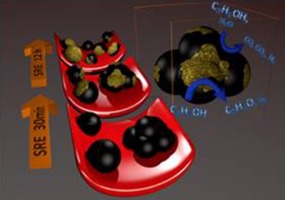Molecular Catalysis ( IF 4.6 ) Pub Date : 2018-03-20 , DOI: 10.1016/j.mcat.2018.02.011 Alberto Rodriguez-Gomez , Alfonso Caballero

|
In this study, five mono and bimetallic xNi-(10-x)Co/SBA-15 catalysts (x = 10, 8, 5, 2 and 0, with a total metallic content of 10 wt%) have been synthesized using a deposition-precipitation (DP) methodology. Catalytic performances on the steam reforming of ethanol reaction (SRE) have been determined and correlated with their physical and chemical state. A nickel content of 5% or higher yields catalytic systems with good activity, high selectivity to hydrogen and a low production of acetaldehyde (less than 5%). However, in the systems where the cobalt is the main component of the metallic phase (8–10%), the selectivity changes, mainly due to the production of an excess of acetaldehyde, which is also reflected in the larger H2/CO2 ratio. In agreement with previous findings, this important modification in the selectivity comes from the formation of a cobalt carbide phase, where only takes place in the cobalt enriched systems, and is inhibited with nickel content larger than 5%. The formation of this carbide phase seems to be responsible for the decrease of cobalt particle size during the SRE reaction. Even though this cobalt carbide phase is thermodynamically metastable against decomposition to metallic cobalt and graphite carbon, our results have shown that it only reacts and decomposes after a hydrogen treatment at 600 °C.
中文翻译:

用于乙醇重整的双金属Ni-Co / SBA-15催化剂:钴如何改变镍金属相和产物分布
在这项研究中,使用沉积法合成了五种单和双金属xNi-(10-x)Co / SBA-15催化剂(x = 10、8、5、2和0,总金属含量为10 wt%) -沉淀(DP)方法。已经确定了在乙醇反应(SRE)的蒸汽重整上的催化性能,并将其与其物理和化学状态相关联。镍含量为5%或更高会产生具有良好活性,对氢的选择性高和乙醛产量低(小于5%)的催化体系。但是,在以钴为金属相主要成分(8-10%)的系统中,选择性发生变化,这主要是由于产生了过量的乙醛,这也反映在较大的H 2 / CO 2中。比率。与先前的发现一致,选择性的这一重要改变来自碳化钴相的形成,该碳化钴相仅在富钴系统中发生,并且镍含量大于5%时受到抑制。碳化物相的形成似乎是造成SRE反应过程中钴粒度降低的原因。即使该碳化钴相在热力学上对分解成金属钴和石墨碳而言是亚稳态的,我们的结果表明,它仅在600°C的氢气处理后才会发生反应和分解。


























 京公网安备 11010802027423号
京公网安备 11010802027423号